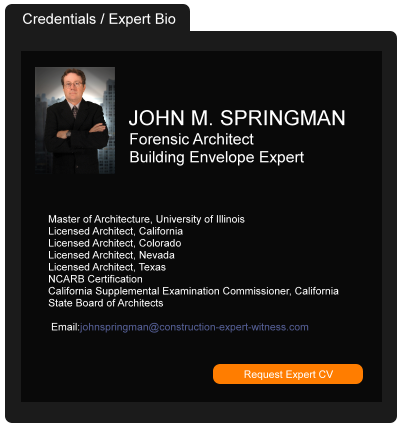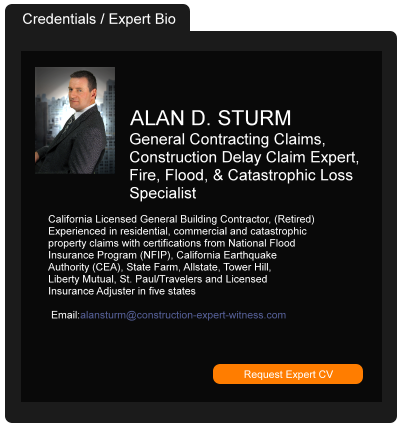General Indemnity Agreement Can Come Back to Bite You
October 21, 2019 —
Christopher G. Hill - Construction Law MusingsI talk about payment bonds often here at Construction Law Musings. I talk a bit less about performance bonds and even less about the General Indemnity Agreements (GIA) that are signed by companies and their principals as part of the agreement between a construction company and its bonding company for the provision of these bonds. However, this does not mean that these GIA’s are not important. In fact, these are the agreements that allow a bonding provider to recoup any money paid out pursuant to either a payment or performance bond.
A 2018 case illustrates their importance. In Allegheny Cas. Co. v. River City Roofing, LLC, the Court considered a claim by Allegheny seeking both specific performance of the collateral agreement and reimbursement of certain expenses and investigative costs expended by Allegheny pursuant to its performance bond. Allegheny sought to be reimbursed for certain payments for siding work, investigative costs, and costs spent enforcing the GIA. Allegheny further sought to force the defendants to post sufficient collateral. To do so, Allegheny sued in the Eastern District of Virginia and then moved for summary judgment stating that the GAI uneuivocally required such a result due to the good faith payment for the siding work and the plain language of the GIA.
In response, the Defendants, River City Roofing and its principals that had personally guaranteed the indemnity, argued that the GIA did not apply to the siding work because only the roofing contract was subject to the performance bond and that any bond claims for which collateral was demanded were inchoate and therefore not proper for specific performance.
Read the court decisionRead the full story...Reprinted courtesy of
The Law Office of Christopher G. HillMr. Hill may be contacted at
chrisghill@constructionlawva.com
Construction Defect Bill a Long Shot in Nevada
June 28, 2013 —
CDJ STAFFConstruction defect reform may still be on the table in Nevada, according to the Reno Gazette Journal. Assembly member Pat Hickey got a committee hearing for Assembly Bill 504 on Sunday. The bill is backed by the construction industry and opposed by trial lawyers. Hickey told the Assembly Commerce and Labor committee that “this bill is not perfect, I would like for it to do more,” and said that without changes Nevada will “continue to reward litigation over resolution.”
AB504 would, among other provisions, provide some protection to subcontractors from the actions of general contractors, though Ira Hansen, an assembly member from Sparks and the owner of a plumbing business, called it a “backhanded slap.” The Gazette noted that similar language pertaining to subcontractors was in AB367, which is sponsored by Democrats. Hickey and Hansen are both Republicans.
Read the court decisionRead the full story...Reprinted courtesy of
Contract Construction Smarts: Helpful Provisions for Dispute Resolution
June 03, 2019 —
Christopher G. Hill - Construction Law MusingsFor this week’s Guest Post Friday, Musings welcomes back Doug Reiser (@douglasreiser), though from new digs. Doug is a construction attorney, LEED AP and the principal at Reiser Legal LLC in Seattle, WA. His office provides effective construction counsel for businesses in the construction industry. He also runs the Builders Counsel Blog, a blog focused on progressive issues in Washington construction law. Doug is a former partner/member at Wolfe Law Group LLC and former owner and director of Express Lien Inc.
There are many types of attorneys out there, but there are certainly two styles: ones looking for the fight and ones trying to prevent the fight. I take the preventative approach. Client funds do not grow on trees. That old saying “an ounce of prevention is worth a pound of cure” should say a “ton of cure.” It’s that valuable.
Sometimes the problem for prevention attorneys is trying to relay that message to a construction business. The cost of smart prevention is mainly thought of as just that – a cost. But when it buys you a cure for pennies on the dollar, it’s worth it. You will know it’s worth it when you finally become engaged in a costly three year long legal proceeding over a construction dispute.
Read the court decisionRead the full story...Reprinted courtesy of
The Law Office of Christopher G. HillMr. Hill may be contacted at
chrisghill@constructionlawva.com
It’s All a Matter of [Statutory] Construction: Supreme Court Narrowly Interprets the Good Faith Dispute Exception to Prompt Payment Requirements in United Riggers & Erectors, Inc. v. Coast Iron & Steel Co.
May 30, 2018 —
Erinn Contreras & Joy O. Siu - Sheppard Mullin Construction & Infrastructure Law BlogOn May 14, 2018, the California Supreme Court issued its opinion in United Riggers & Erectors, Inc. v. Coast Iron & Steel Co., No. S231549, slip. op. (Cal. Sup. Ct. May 14, 2018). In it, the Court narrowly construed the “good faith” exception to the general rule that a direct contractor must make retention payments to its subcontractors within 10 days of receiving any retention payment. The exception provides that “[i]f a good faith dispute exists between the direct contractor and a subcontractor, the direct contractor may withhold from the retention to the subcontractor an amount not in excess of 150 percent of the estimated value of the disputed amount.” Cal. Civ. Code section 8814(c).
Reprinted courtesy of
Erinn Contreras, Sheppard Mullin and
Joy O. Siu, Sheppard Mullin
Ms. Contreras may be contacted at econtreras@sheppardmullin.com
Ms. Siu may be contacted at jsiu@sheppardmullin.com
Read the court decisionRead the full story...Reprinted courtesy of
Sacramento Army Corps District Projects Get $2.1 Billion in Supplemental Appropriation
September 04, 2018 —
Greg Aragon - Engineering News-RecordThe U.S. Army Corps of Engineers Sacramento District has received supplemental funding for five District projects, totaling an investment of more than $2.1 billion in flood risk management efforts.
Read the court decisionRead the full story...Reprinted courtesy of
Greg Aragon, ENRENR may be contacted at
ENR.com@bnpmedia.com
40 Year Anniversary – Congratulations Ed Doernberger
November 23, 2016 —
Tracy Alan Saxe - Saxe Doernberger & Vita, P.C.Forty years ago, on the Big Island of Hawaii,
Edwin L. Doernberger was sworn in as an attorney. Fifteen years ago, Ed rejoined two former partners to help build an exciting new boutique insurance policyholder practice. Today, Saxe Doernberger & Vita is pleased to celebrate the 40th anniversary of its most distinguished partner.
“Ed’s energy and enthusiasm are undiminished,” said co-founder and Managing Partner, Tracy Alan Saxe. “He’s still one of the firm’s most active litigators.” Ed has extensive appellate experience, having argued before the Connecticut and Hawaii Supreme and Appellate Courts, New York Appellate Courts, and the Second and Ninth Circuits.
Read the court decisionRead the full story...Reprinted courtesy of
Tracy Alan Saxe, Saxe Doernberger & Vita, P.C.Mr. Saxe may be contacted at
tas@sdvlaw.com
Employee or Independent Contractor? New Administrator’s Interpretation Issued by Department of Labor Provides Guidance
August 04, 2015 —
Tanya Salgado – White and Williams LLPThe question of whether a worker should be classified as an independent contractor or an employee is fraught with confusion and misunderstanding for many businesses. Compounding the problem is the fact that there are a number of different tests used to determine employee status, which vary by jurisdiction and by the particular law in question. For example, the Internal Revenue Service uses the common law rules which focus on the degree of control and independence exercised by the worker. In contrast, the United States Department of Labor uses the “economic realities” test which focuses on whether the worker is economically dependent on the employer.
In an effort to help combat the confusion over proper worker classification, the United States Department of Labor (DOL) has issued a new Administrator’s Interpretation that provides a detailed explanation of the test used by the DOL to determine if a worker has been misclassified as an independent contractor. The DOL enforces the Fair Labor Standards Act (FLSA), which mandates that employees (but not independent contractors) be paid minimum wage and overtime. When a business misclassifies non-exempt workers as independent contractors, and those workers are not paid the minimum hourly wage for their labor, or are not paid overtime when they work more than 40 hours in a workweek, this violates the FLSA.
Read the court decisionRead the full story...Reprinted courtesy of
Tanya Salgado, White and Williams LLPMs. Salgado may be contacted at
salgadot@whiteandwilliams.com
Badly Constructed Masonry Walls Not an Occurrence in Arkansas Law
May 10, 2012 —
CDJ STAFFThe US District Court for Maryland has granted a summary judgment in the case Konover Construction Corp. v. ATC Associates to Massachusetts Bay Insurance Company and denied a request for dismissal from ACT. Konover (KBE) was contracted by Wal-Mart to build a Wal-Mart store and a Sam’s Club in Port Covington, Maryland. Superus, Inc. was hired by KBE to build the masonry walls. Superus purchased a policy from Massachusetts Bay Insurance which named KBE as an additional insured. Wal-Mart hired ATC Associates to independently test and inspect the concrete structural steel, and masonry.
�After the building was in use, a large crack appeared which was attributed a latent construction defect. Other cracks were discovered. Upon investigation, it was discovered that there were “voids or foam in the concrete block surrounding the reinforcing steel that should have been filled with grout,” and in some cases, “reinforcing steel was missing or not installed in accordance with the specifications.” KBE paid for the repair and remediation and Wal-Mart assigned all rights and interests against ATC to KBE.
�KBE filed suit against ATC. ATC called for dismissal on the grounds that Wal-Mart had no claims as the problems had been remediated. Wal-Mart then provided KBE with additional agreements to give them enforceable rights against ATC and Superus. KBE filed a fourteen claims against ATC, Superus, and Massachusetts Bay. In the current case, Massachusetts Bay sought summary judgment and ATC sought dismissal of all claims against it.
�Massachusetts Bay claims that they need not indemnify Superus, as “there is no evidence adequate to establish that Superus’ defective work caused any collateral and/or resulting damage that was not subject to an Impaired Property exclusion, and that, in any event, no damage occurred during the policy period.”
�As Wal-Mart is headquarted in Arkansas, certain contracts were under Arkansas law. Under the Arkansas courts, “defective workmanship, standing alone and resulting in damages only to the work product itself, is not an ‘occurrence.’” The court determined that collateral or resultant damage would be covered. The court found that “it is clear under Arkansas law, and the parties appear to agree, that Massachusetts Bay is not obligated to indemnify KBE for any repairs to the masonry walls themselves, including any cracks or gaps in the walls.” The court also found that “there is no evidence adequate to prove that any allegedly resultant property damage was caused by Superus’ faulty construction of the walls.” The court also noted that “if the building code violation and structural integrity problem were ‘property damage,’ insurance coverage would be barred by the Impaired Property Exclusion.” Based on these findings, the court concluded that Massachusetts Bay is entitled to summary judgment.
�While the court dismissed the case against Massachusetts Bay, the court declined ATC’s motion to dismiss. The court noted that ACT’s alleged negligence in conducting inspections “created only a risk of economic loss for KBE.” Although hired by Wal-Mart, ATC “transmitted its daily testing and inspection reports of the Wal-Mart and Sam’s Club projects directly to KBE.” The court found that “KBE has made a plausible claim.”
�ATC also claimed that KBE contributed to the negligence due to the negligence of its subcontractor. The court concluded that it was plausible that “ATC will not be able to carry its burden of proving KBE was contributorily negligent.” The court was less sanguine about KBE’s fraud claim, but though it “may not now appear likely to have merit, it is above the ‘plausibility’ line.”
�In conclusion, KBE may not continue its case against Massachusetts Bay. However, the judge allowed the other proceedings to continue.
�Read the court’s decision…
� Read the court decisionRead the full story...Reprinted courtesy of


































































